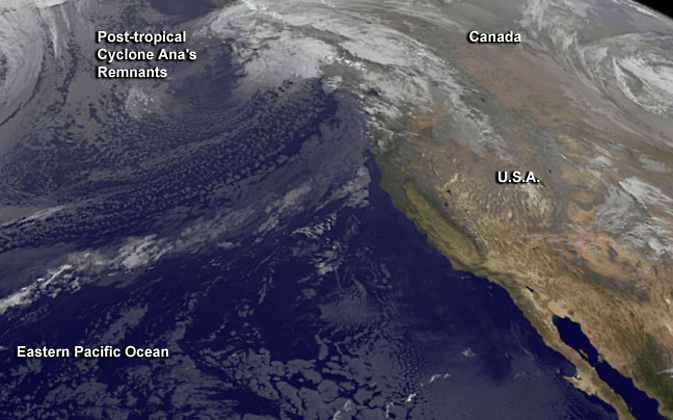Ana's Remnants Raining and Gusting in British Columbia, Canada

Post-tropical cyclone Ana's remnant clouds resemble a frontal system in this image from NOAA's GOES-West satellite. Image Credit: NASA/NOAA GOES Project
Wind warnings along some coastal sections of British Columbia continued today as the storm moved through the region.
NOAA's GOES-West satellite gathered infrared data on Ana's remnant clouds and that data was made into an image by NASA/NOAA's GOES Project at NASA's Goddard Space Flight Center in Greenbelt, Maryland. In the image the remnant clouds resemble a frontal system.
Environment Canada's Meteorological Service continued wind warnings for British Columbia's Central coast, East Vancouver Island, North Vancouver Island and the Sunshine Coast The warning noted strong winds may cause damage. Strong southeast winds of 56 mph (90 kph) over exposed coastal sections will continue during the morning of Oct. 28.
At 8 a.m. EDT on Oct. 28, Victoria Int'l Airport in Victoria, British Columbia reported light rain with sustained winds near 21 mph (34 kph) and gusts to 29 mph (47 kph). Vancouver International Airport reported light rain with sustained winds near 16 mph (26 kph) from the east.
The local forecast calls for skies to clear as the remnants of Ana to move east by Wednesday, Oct. 29.
Environment Canada meteorologists will update alerts as required. For updates, visit: http://weather.gc.ca.
Rob Gutro
NASA's Goddard Space Flight Center
Media Contact
More Information:
http://www.nasa.gov/content/goddard/ana-central-pacific/All latest news from the category: Earth Sciences
Earth Sciences (also referred to as Geosciences), which deals with basic issues surrounding our planet, plays a vital role in the area of energy and raw materials supply.
Earth Sciences comprises subjects such as geology, geography, geological informatics, paleontology, mineralogy, petrography, crystallography, geophysics, geodesy, glaciology, cartography, photogrammetry, meteorology and seismology, early-warning systems, earthquake research and polar research.
Newest articles

Superradiant atoms could push the boundaries of how precisely time can be measured
Superradiant atoms can help us measure time more precisely than ever. In a new study, researchers from the University of Copenhagen present a new method for measuring the time interval,…

Ion thermoelectric conversion devices for near room temperature
The electrode sheet of the thermoelectric device consists of ionic hydrogel, which is sandwiched between the electrodes to form, and the Prussian blue on the electrode undergoes a redox reaction…

Zap Energy achieves 37-million-degree temperatures in a compact device
New publication reports record electron temperatures for a small-scale, sheared-flow-stabilized Z-pinch fusion device. In the nine decades since humans first produced fusion reactions, only a few fusion technologies have demonstrated…





















